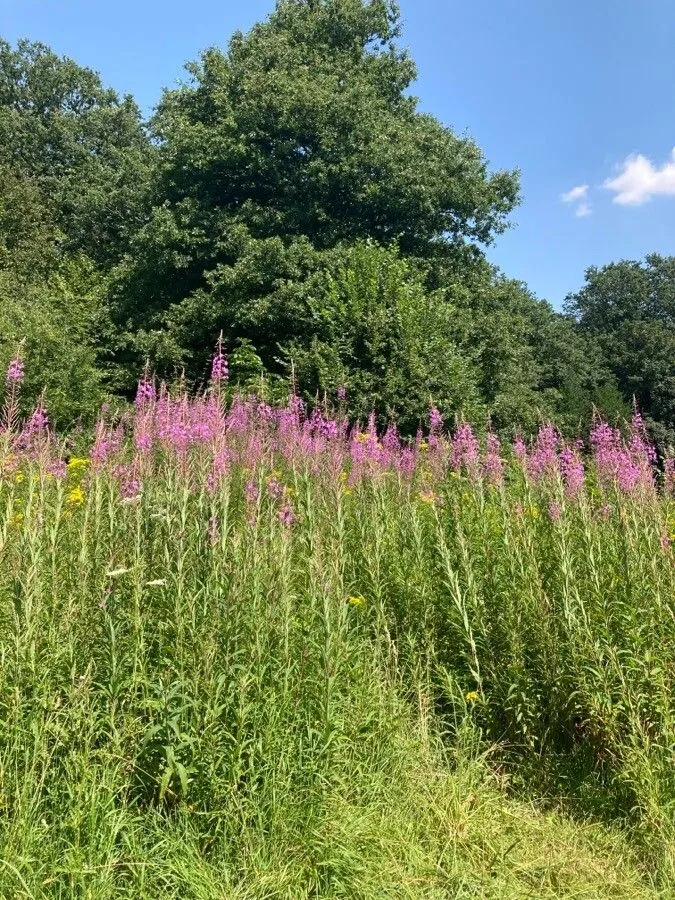
Author: L.
Bibliography: Sp. Pl.: 347 (1753)
Year: 1753
Status: accepted
Rank: species
Genus: Epilobium
Vegetable: False
Observations: Temp. Northern Hemisphere to NE. Mexico, Morocco
Rosebay willowherb, scientifically known as Epilobium angustifolium and also referred to as Chamerion angustifolium in some classifications, is a striking perennial belonging to the Onagraceae family. This plant has a historical background, being first described in Carl Linnaeus’s seminal work, “Species Plantarum” in 1753, providing a foundational reference for its identification and classification.
Rosebay willowherb thrives primarily in the temperate regions of the Northern Hemisphere, extending its range as far south as northeastern Mexico and Morocco. This hardy herb flourishes in a variety of environments but is particularly noted for its rapid colonization of disturbed sites, including areas affected by fire, logging, or other forms of soil disruption. It is, therefore, a common sight in meadows, along roadsides, and in open woodlands where sunlight is plentiful.
Characteristically, Rosebay willowherb displays tall, spire-like stems that can reach impressive heights, often ranging between 1 to 2 meters. The plant is adorned with slender, willow-like leaves that give it part of its common name. One of its most striking features is the dense, spiky clusters of vibrant pink to magenta flowers that bloom during the summer months, creating a visually captivating display that attracts numerous pollinators, including bees and butterflies.
The blooming period of Rosebay willowherb is not only a highlight for nature enthusiasts but also plays a pivotal role in its reproductive strategy. The flowers develop into slender, elongated seed pods which, upon maturation, split open to release an abundance of tiny seeds attached to silky, feathery plumes. These plumes are an ingenious adaptation, allowing the seeds to be carried far distances by wind, thus facilitating widespread dissemination.
In addition to its ecological benefits, Rosebay willowherb also holds various traditional uses. Indigenous peoples and early settlers utilized different parts of the plant for medicinal purposes. The young shoots, for example, were often harvested and consumed much like asparagus, while the leaves were sometimes brewed into tea.
In summary, Epilobium angustifolium, or Rosebay willowherb, is a resilient, versatile, and ecologically significant plant hailing from the Onagraceae family. Its ability to thrive in disturbed environments, coupled with its stunning floral display, ensures that it remains a prominent component of the temperate Northern Hemisphere flora.
En: Rosebay willowherb, French-willow, Great willowherb, Willowherb, Fireweed, Great Willow Herb, Wickup
Ca: Cameneri
Cs: Vrbovka úzkolistá
Nl: Knikkend Wilgeroosje
Fr: Epilobe en Épi, Épilobe à feuilles étroites, Épilobe en épi, Laurier de saint Antoine, Antoinette, Fausse Lysimaque, Osier de saint Antoine, Osier fleuri, Plante à feu
De: Schmalblättriges Weidenröschen, Staudenfeuerkraut, Wald-Weidenröschen, Waldweidenröschen
It: Garofanino Maggiore, Erba di Sant’Antonio
Ko: Bun-hong-ba-neul-kkot
Sk: Kyprina úzkolistá
Taken Sep 23, 2021 by Jacques Zuber (cc-by-sa)
Taken Aug 6, 2021 by Jacques Zuber (cc-by-sa)
Taken Jul 8, 2019 by Stefan Kamps (cc-by-sa)
Taken Aug 1, 2021 by Jen Jones (cc-by-sa)
Taken Dec 21, 2021 by kathomas (cc-by-sa)
Taken Jul 31, 2017 by Titouan Lorieul (cc-by-sa)
Taken Oct 30, 2019 by honzafm (cc-by-sa)
Taken Jul 8, 2019 by Stefan Kamps (cc-by-sa)
Taken Aug 1, 2021 by Jen Jones (cc-by-sa)
Taken Dec 27, 2020 by Audrey Betus (cc-by-sa)
Taken Sep 21, 2021 by san vicente ludmila (cc-by-sa)
Taken Aug 20, 2019 by Pour Demos (cc-by-sa)
Taken Oct 15, 2017 by Fejul Xeto (cc-by-sa)
Taken Aug 1, 2022 by Micheli Daniele (cc-by-sa)
Taken Jul 2, 2018 by Cruz Fer (cc-by-sa)
Taken Aug 15, 2019 by Juanma Crespo (cc-by-sa)
Taken Sep 17, 2017 by Tercie Kadan (cc-by-sa)
Taken Sep 11, 2015 by Philippe Bissières (cc-by-sa)
Taken Sep 8, 2021 by Marek Hrdina (cc-by-sa)
Taken Sep 11, 2015 by Philippe Bissières (cc-by-sa)
Taken Jul 4, 2020 by Rico Mende (cc-by-sa)
Taken Aug 23, 2019 by Hugo Maleysson (cc-by-sa)
Taken Jul 22, 2011 by Tela Botanica − Yoan MARTIN (cc-by-sa)
Taken Jul 11, 2022 by Jacek Wnuk (cc-by-sa)
Taken Aug 20, 2019 by Pour Demos (cc-by-sa)
Taken Jun 20, 2022 by Ramon Gadellaa (cc-by-sa)
Taken Jul 25, 2022 by Fatih Türk (cc-by-sa)
Taken Aug 5, 2019 by Sandra Menkens (cc-by-sa)
Taken Aug 5, 2019 by Andreas Macht (cc-by-sa)
Taken Aug 23, 2019 by Michel Cosme (cc-by-sa)
© copyright of the Board of Trustees of the Royal Botanic Gardens, Kew.
© copyright of the Board of Trustees of the Royal Botanic Gardens, Kew.
© copyright of the Board of Trustees of the Royal Botanic Gardens, Kew.
Ph maximum: 5.5
Ph minimum: 5.0
Light: 5
Atmospheric humidity: 5
Bloom months: [‘jun’, ‘jul’, ‘aug’, ‘sep’]
Soil nutriments: 7
Family: Myrtaceae Author: (F.Muell.) K.D.Hill & L.A.S.Johnson Bibliography: Telopea 6: 402 (1995) Year: 1995 Status:…
Family: Rubiaceae Author: Pierre ex A.Froehner Bibliography: Notizbl. Bot. Gart. Berlin-Dahlem 1: 237 (1897) Year:…
Family: Sapindaceae Author: Koidz. Bibliography: J. Coll. Sci. Imp. Univ. Tokyo 32(1): 38 (1911) Year:…
Family: Asteraceae Author: A.Gray Bibliography: Pacif. Railr. Rep.: 107 (1857) Year: 1857 Status: accepted Rank:…
Family: Fabaceae Author: Medik. Bibliography: Vorles. Churpfälz. Phys.-Ökon. Ges. 2: 398 (1787) Year: 1787 Status:…
Family: Aspleniaceae Author: (Cav.) Alston Bibliography: Bull. Misc. Inform. Kew 1932: 309 (1932) Year: 1932…